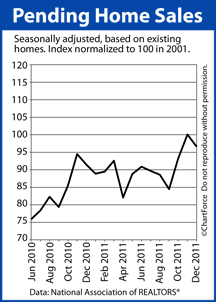
After 3 consecutive months of growth, the housing market appears to have eased a bit in December.
According to the National Association of REALTORS®, December’s Pending Home Sales Index slipped 4 percent from the month prior. The index measures the number of homes under contract to sell nationwide, but not yet sold.
Despite falling below its benchmark “100 value”, December’s Pending Home Sales Index is the reading’s second-highest value since April 2010 — the last month of last year’s home buyer tax credit program.
In other words, the housing market continues to show signs of improvement, propelled by low home prices and the cheapest mortgage rates of all-time.
Freddie Mac’s mortgage rate survey put the 30-year fixed rate mortgage at an average of 3.96% in December — a 75-basis point improvement from December 2010. This helps to make homes more affordable nationwide.
On a regional basis, December’s Pending Home Sales Index varied :
- Northeast Region: -3.1 percent from November 2011
- Midwest Region : +4.0 percent from November 2011
- South Region : -2.6 percent from November 2011
- West Region : -11.0 percent from November 2011
But even regional data is only so helpful. Like everything in real estate, data must be local to be relevant.
Throughout the West Region, for example, the U.S. region in which pending home sales fell the most, several states must have performed better than the regional average. And, undoubtedly, there were cities, towns, and neighborhoods that experienced marked market growth.
Unfortunately, the Pending Home Sales Index can’t capture that data. Nor can it identify the markets in which home sales suffered.
For today’s Columbus home buyers and sellers, therefore, it’s important to understand your local market and the drivers of local activity. Reports like the Pending Home Sales Index can paint a broad picture U.S. housing but for data that matters to you, you’ll want to look local.
For local real estate data, talk to an experienced real estate professional.
